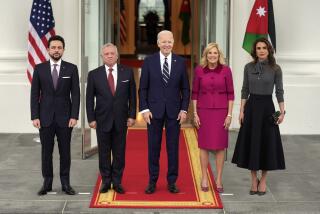Cheney Takes Anti-Terror Message to Mideast
- Share via
AMMAN, Jordan — As he arrived Tuesday in the Middle East, Vice President Dick Cheney stepped from the shelter of his high-security jet, through the cordon of a kaffiyeh-clad honor guard and directly into what could be the toughest mission of his tenure.
Underlying his very public journey through the Middle East is very private diplomacy. In the end, his efforts could help determine whether President Bush gains the widespread international support he seeks to carry his war against the Al Qaeda network beyond Afghanistan and deny the terrorists sanctuary anywhere in the Islamic world.
Traveling far from the “secure, undisclosed location” to which he was dispatched in the immediate aftermath of Sept. 11, he is the highest-level--and most visible--U.S. official to venture to the Middle East since the attacks.
He began the job Tuesday night at Baraka Palace with Jordan’s King Abdullah II, the young monarch who is the beneficiary of U.S. support but is nevertheless skeptical about Cheney’s mission.
The two men spent about two hours together, in a private meeting and then with aides and at dinner, a White House official said. The official, speaking on condition of anonymity, said Cheney noted the role that Jordan has played in Afghanistan, setting up the first hospital for the U.S.-led coalition and helping remove land mines.
“They’ve been a big help in Afghanistan. It’s very positive to have an Arab member of the coalition with troops on the ground,” another Cheney aide said.
Such compliments aside, Abdullah “expressed hope for a solution to all outstanding problems with Iraq through dialogue and peaceful means,” the king’s office said in a palace statement--sending a clear, public signal of reluctance to sign on to the Bush administration’s efforts against Baghdad.
The statement also said Abdullah voiced Jordan’s concern about “the repercussions of any possible strike on Iraq and the dangers of that on the stability and security of the region.”
In a rare measure, the vice president is flying aboard the aircraft commonly used as Air Force One to transport the president. It offers greater capacity, the vice president’s aides said, for the expanded delegation accompanying him. It also brings security, sophisticated communications gear, convenience and the unmistakable imprimatur of the White House.
That could be useful in itself.
The challenge facing Cheney is this: The United States wants to eliminate the threat that the Bush administration says is posed by chemical weapons and possibly other weapons of mass destruction in the Iraqi arsenal.
With the Jordanian prime minister, Ali abu Ragheb, at his side, Cheney said on his arrival that he and the king would discuss the violence tearing apart Israel and the Palestinian territories and the war in Afghanistan, but also “the threat that weapons of mass destruction pose to all of us.” That was code for Iraq, and the weapons’ potential reach throughout the region.
But the would-be allies whom Cheney is courting recognize that Iraqi President Saddam Hussein remains popular among Palestinian and other Arab populations, if not among Persian Gulf and Middle East elites, and any attack would be certain to anger what is known as the “Arab street.”
Abdullah met Sunday with a senior Iraqi official, Izzat Ibrahim. The vice chairman of Hussein’s Revolutionary Command Council told Abdullah that “a strike on Iraq will be disastrous for Iraq and the region as a whole and will threaten the security and stability of the Middle East,” a palace statement said.
Cheney’s 11-day, 12-nation trip, which began in London on Sunday and will include nine Arab nations, Israel and Turkey, nearly circumnavigates Iraq. It puts the vice president, whose only foreign travel during his nearly 14 months in office has been to Canada, directly into a region from which Al Qaeda has drawn its membership and to which it might try to disperse.
This is not unknown territory for the vice president.
As chief executive officer of energy giant Halliburton Co., Cheney worked long-standing contacts with Middle Eastern and Persian Gulf leaders.
Before that, as defense secretary in the first Bush administration, he was the voice of impending military operations in the weeks and months leading to the 1991 Persian Gulf War. He traveled the same circuit he is on now, just before the fighting broke out, to make certain that political and military support was in place among the gulf emirs.
But the world has changed since then.
“The whole information revolution has taken place since the early ‘90s, when public opinion wasn’t a factor. Now, with some 21 Arabic TV channels and all that information out there, the people make up their own minds without respect to what their governments want them to think,” said Edward S. Walker, president of the Middle East Institute in Washington and a former U.S. ambassador to Egypt and Israel.
Nor is Cheney in unfamiliar political territory.
Among the traditional roles of the vice president in the modern era is that of carrying the president’s message around the country--and catching political flak for the president. Now he’s doing it on an international stage.
On this trip, said Kenneth M. Duberstein, who was Ronald Reagan’s final White House chief of staff, “he isn’t just the javelin thrower. He’s the javelin catcher as well.”
More to Read
Sign up for Essential California
The most important California stories and recommendations in your inbox every morning.
You may occasionally receive promotional content from the Los Angeles Times.













